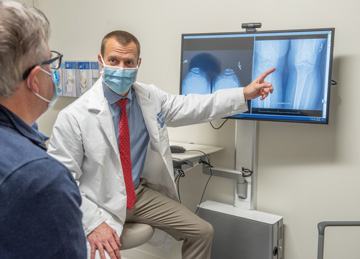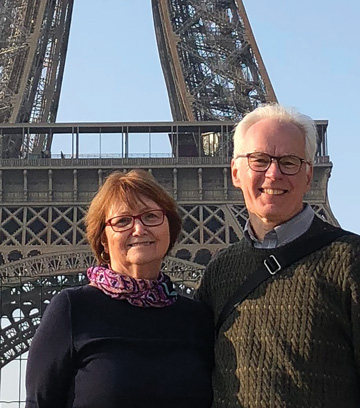The success of Henry Ford’s outpatient joint replacement program is built on a strong patient selection process. Dr. Charters makes sure patients are medically appropriate for same-day discharge and have no significant comorbidities or major
heart or lung problems. He also considers if they’ll be physically able to function independently following surgery, perhaps with the help of a cane or walker, and have a strong support system in place.
“Joint replacement is an elective surgery, so patients having caregivers at home to help out during their recoveries is very important,” says Dr. Charters. “Patients who don’t have a friend, family member, neighbor or someone
who can assist them during the first few days post-op shouldn’t be discharged on the day of surgery.”
He identifies pain management as another key component of successful total joints programs. At Henry Ford, this includes getting patients up and moving soon after surgery, a factor that correlates to less post-op discomfort, and optimizing the
use of a multimodal pain management protocol.
“Most patients receive a short-acting spinal anesthetic that wears off quickly with minimal side effects,” says Dr. Charters. “This helps to reduce the grogginess and nausea that patients can experience after receiving general
anesthesia — factors that can impede their ability to ambulate.”
To help control pain in total knee patients, surgeons inject a local anesthetic around the joint during surgery and anesthesiologists place nerve catheters attached to pain pumps, which provide relief for three to five days post-op.
Additionally, patients follow an analgesic plan that uses a combination of medications, physical therapy and other techniques to prevent pain, with opioids available as a last resort. “My patients recover at home with Tylenol, anti-inflammatories,
ice and a nerve catheter,” says Dr. Charters. “I tell them that they should take opioids only as a rescue medication to manage breakthrough pain when those treatments don’t work.”
Ms. Alan says the program’s pain management plan was very effective and adds that she was never in a lot of discomfort after her procedure.
Educating patients on what to expect before and after surgery is another key aspect of successfully performing total joints in outpatient facilities. Ms. Alan received a comprehensive booklet that outlined everything she needed to know about her
pre-, intra- and post-op care. If she had a question about any aspect of it, answers were always a phone call away. “The team of providers were readily available, and that took away a lot of my anxiety about the entire process,”
says Ms. Alan.
Improved clinical approaches and engaging patients to become active participants in their own care are contributing to the steady growth of outpatient total joints. “Patients ask me all the time about the technology that’s making the
movement possible,” says Dr. Charters. “The implants are the same and most of the instrumentation is the same. Over time we’ve made the procedure less invasive, but I think the two biggest factors are getting patients moving
soon after surgery and the effectiveness of multimodal pain management protocols.”
When Dr. Charters was in residency in 2009, joint replacement patients would lie in a hospital bed overnight before their first physical therapy session. “Now, patients are in our care for eight hours from start to finish,” he says.
“They’re beginning physical therapy within a few hours of surgery and heading home soon after.”
As for Ms. Alan, her new hip continues to feel great and she made it to Paris with her husband. “I’m back to being the active person I once was,” she says. “I’m still amazed by the results of the surgery and how quickly
I recovered.” OSM
.svg?sfvrsn=be606e78_3)


.svg?sfvrsn=56b2f850_5)